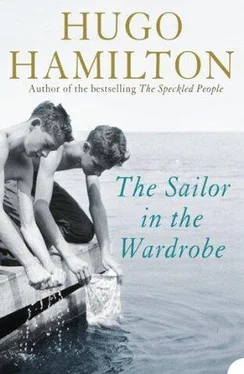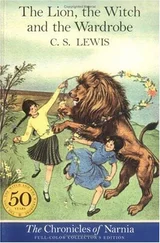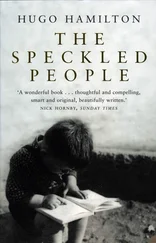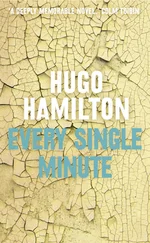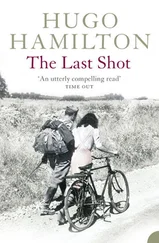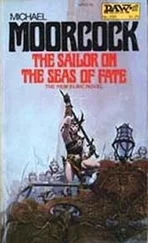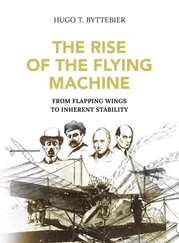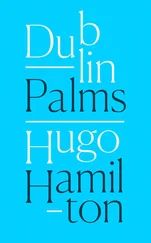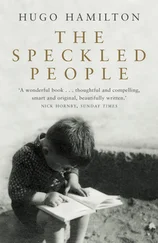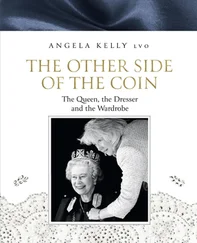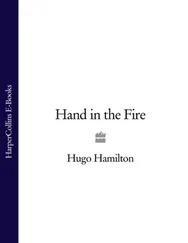In the towns of Leap and Glandore and Union Hall and Skibbereen, all around that area of West Cork, there was a story going around for a long time about a landlord whose carriage was seen passing by, on fire. It was like an Irish nightmare that kept coming back whenever it was getting dark or when there was a storm coming and the trees were beginning to sway in the wind. Children were afraid of seeing it and the people around West Cork could not put the fiery carriage out of their minds because it went back a long way in Irish history and was passed down through generations. Stories were the only way of remembering things, and they would often tell this one of how they looked up suddenly to see the flaming carriage speeding across the side of a hill at dusk. Some said they caught a glimpse of the flames in the woods, crackling and throwing off sparks. The sound of hoofs would come past them along the road without warning, and they would look up to see the flaming carriage rushing away across the lonely landscape towards the coast. The horses would be seen charging into the sea to try and put an end to it, but nothing could extinguish the flames, just as nothing could extinguish a story that came from the truth. Each time it went away, it always came back again with the landlord trapped inside his burning carriage, sitting in the back, staring with his dark, guilty eyes out through the flames at the people he had treated with such cruelty.
My father says he saw the carriage once when he was very small and he will never forget the look of horror in the landlord’s eyes, condemned for ever to burn in this travelling hell for his past injustice towards the people. My father never believed in legends. He never tried to scare us with ghost stories, only real facts. And there was something about this story that was based in fact, something more than just a bit of folklore from a time when people had no television, and these stories were the only way that facts could be transmitted and kept in your mind. He said it was a story like the Flying Dutchman, a story that some Irish composer would make into great, world-famous opera one day. I remember how, on the night before we cycled to West Cork, he opened the glass bookcase in the front room and said there was something he wanted to show us, something to do with this fiery carriage.
He took out a small, thin notebook with a black cover. It was very old and worn, with rounded corners and a few age spots. He wanted us to hold it in our hands, Franz first, then me. He pointed to the calendar at the back from the year 1892 and said it was a very valuable document, not like the book from Mainz that my mother has in the oak trunk, but valuable in a different way because it tells the story of Ireland, a story that should be kept safe and should never be taken out of the house because it might be lost. The writing inside belongs to my greatgrandfather, Taidhg Ó Donabhain Daill, Ted O Donovan Blind, the land surveyor who was not blind himself but descendant of a blind man, and decided at one point to start collecting all the names of places in the Irish language so that they wouldn’t disappear. My father showed us the lists of place names around West Cork where he grew up and says you could follow your way along the coastline by these names. Every inlet, every harbour, every cliff and every rock is written down in the old handwriting and we’re lucky he wrote with a lead pencil because that doesn’t fade like ink.
He’s shown me this book a number of times since then. There are names like Carraig Árd and the English translation beside it, High Rock. Carraig a’choiscéim , the rock of steps. The rock of two women. The rock of seals. Dead man’s rock. There’s even a rock called Carraig a’chaca , the rock of shit, which looks like a white skull because of the seagulls and cormorants. Some of the places have notes in English on distances and dangers around the coast. Descriptions of how the land looks like an elbow or a foot or goat’s udder, coves that look like a short thumb and forefinger going out into the sea. The distances between Sherkin Island and Cape Clear Island. My father reads out the words of his own grandfather: ‘No landing places south sides — the cliffs are too high. Strong currents. I had to stay in Cape Clear one time 10 days.’
The book also had a lot of proverbs that were collected by Ted O Donovan Blind along the way and my father reads out the very last.
‘Trí fithid bean nucht a chuirim chugat, agus mo bheannacht féin chomh maith . Three score naked women I send you, and my own blessing as well.’
He laughs and explains how the word in the Irish language for a naked woman sounds exactly the same as the word for blessing. He says you can explain this in German or in English, but there are some jokes that can only be laughed at in Irish.
My father lets us hold his ancient book, in the same way that my mother allows us to look through her ancient book. They want us to feel close to the time in the past when these books were printed or written. They want us to be witnesses. They want us to be time-travellers, living in the past, sometime in the nineteenth century in West Cork, or even further back in the seventeenth century in Mainz. They want us to keep all that history in our heads. But you can’t remember something that you have not seen with your own eyes. You can remember people talking about things that happened long ago, but you can’t remember things that you have not witnessed.
The last thing my father showed us from his little frail book was one particular name of a place along the coast, not far from where they lived. It’s called Toehead. It came from the Irish name Ceann Tuaithe, which means headland. Along the coast road out of Skibbereen, he explained, not far from Glandore, we would be coming across this headland which we would never forget because of the extraordinary view. There was nothing much out there now, he said, only sheep grazing. But there was a time around the great Irish famine when three hundred families were living on that headland. My father reads out the small note after the name.
Ceann Tuaithe — Toehead. Around 300 families lived here. All evicted. Barren place now.
My father told us there were stories going around that some people were driven off the cliffs. After the great famine in Ireland, the British government introduced a new policy which was intended to put an end to unproductive farming. It was a bit like the collectivization in Russia under Stalin, my father said. There was a lot of trouble in Ireland when people decided to stop paying their rent and were evicted by landlords. The Congested Districts Board was set up to alleviate poverty and bad living conditions. But there was also a policy of assisted emigration and land clearances. My father talked about evictions and a law called the Gregory Clause. He said the people of Toehead were evicted and Ted O Donovan Blind wrote down the name in his notebook so that it would not be forgotten. The story he heard as a boy was that evictions were carried out by gangs under police supervision. They would wreck the cottages to make sure they could not be re-inhabited. Some of the thatched cottages on the headland were set on fire. And that’s how the story of the landlord and his fiery carriage emerged, when the flames from the roofs of the cottages were carried by the wind and as the landlord passed by on the road to see that the job was done properly, his carriage caught fire and he was condemned for ever by the people to live in his travelling hell.
I remember my father telling me this story. But you cannot remember things that happened before you were born. I can only remember what I have seen for myself. I remember that we cycled all the way from Dublin, stopping at hostels and staying with relatives in Tipperary and Fermoy, right down to Skibbereen. I can remember finding a packet of cigarettes that somebody had dropped on the ground. We ate the last piece of cake outside a shop near Fermoy. We saw a truck that had crashed outside a public house on the road into Clonakilty. I can remember that it took six days for us to cycle to Cork City and it was raining when we got there. There was nobody we knew living in Leap, but we got off the bikes to look at the house where my father grew up. It was covered with ivy. When I got on the bike again, my trousers were stuck to my legs and it was almost impossible to cycle. It rained so hard that we could not even see where we were going and had to blink all the time to keep our eyes clear. We stayed in Skibbereen with Tante Eileen for a few day, our clothes and our rucksacks hanging in the kitchen over the stove to dry. I can remember her house with a crooked floor. The front of the house had subsided because of years of flooding and the room was at an angle. I remember how it felt like being on a ship, tilted to one side. You could roll a penny down from one end to the other, towards the window.
Читать дальше
Конец ознакомительного отрывка
Купить книгу
